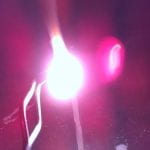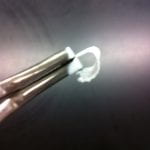DESCRIPTION:
When magnesium is ignited, it is readily oxidized by oxygen in the air producing an incredibly bright light and intense heat.
2Mg (s) + O2 (g) → 2MgO (s)
TOPICS COVERED:
– synthesis reactions
– energy transformations
– chemical change
– light
– exothermic reactions
– color change
MATERIALS NEEDED:
– magnesium ribbon
– lighter
– tongs
PROCEDURE:
1. Holding a strip of magnesium ribbon in the tongs, ignite it
ADDITIONAL COMMENTS:
This demo looks best with the lights in the room off. If the magnesium doesn’t light easily, scrub it with steel wool to remove an oxide layer that may have formed.
SAFETY:
DO NOT look directly at the flame, and instruct students to do the same. Magnesium burns bright enough to cause temporary blindness and is damaging to eyes. Safety goggles should be worn at all times. UV goggles are suggested instead for extra eye protection.
REFERENCES:
Shakhashiri, B.Z. Chemical Demonstrations; University of Wisconsin Press: Madison, 1983; Vol. 1, pp 38 – 39.
This lesson plan‘s topic is reaction types. In this lesson, notes are presented using this PowerPoint then students use their notes to identify the types of reaction in a lab. Igniting Magnesium is Reaction F in this lesson.

